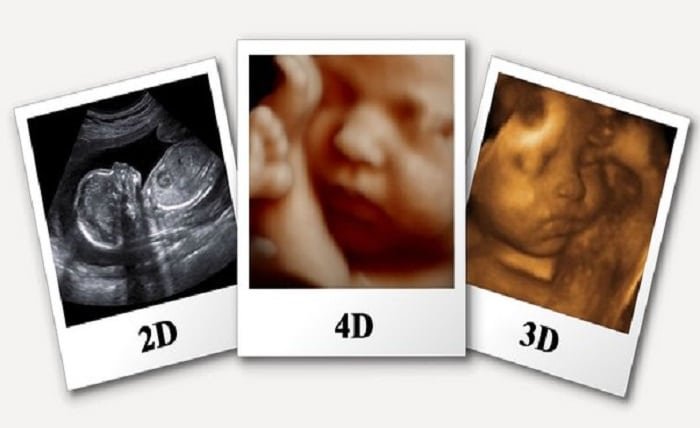It’s hard to put into words the kind of happiness that ultrasound brings to expectant parents. A baby’s heartbeat is a highly emotional feeling for parents-to-be when heard for the first time!
To many parents, getting an ultrasound during pregnancy means seeing your baby and how they look—precious glimpses of their little one. However, the real reason to get an ultrasound check is whether the baby is healthy inside its mother. Is the development of the baby normal? And it doesn’t end here; you can have detailed data regarding your baby’s health using ultrasound technology in pregnancy.
There are types of ultrasounds in pregnancy with the advancement in technologies. In this article, we will discuss different types of pregnancy scans and their reasons and benefits so you will get the knowledge of overall ultrasound.
What is Ultrasound?
An Ultrasound scan (also known as sonography) uses sound waves to create an image of the growing baby and the mother’s reproductive organs. This safe and painless procedure helps check health and development without using radiation. Other than the standard ultrasound, high forms of pregnancy scans exist in 3D and 4D ultrasounds.
These are the safe scans but it’s recommended not to get into tests more than medically necessary. And that’s why there are many reasons for getting an ultrasound during pregnancy.
Let’s discuss it for a clear picture.
Reasons for Pregnancy Ultrasound
Ultrasound scans are used during pregnancy for many reasons. Your doctor may order them if they suspect any issues from earlier tests. Although ultrasounds are safe, doctors advise against unnecessary ones.
In the first trimester (weeks 1-12), ultrasounds are used to:
- Confirm pregnancy
- Check the baby’s heartbeat
- Estimate the due date
- Detect multiple pregnancies
- Inspect the placenta, uterus, ovaries, and cervix
- Identify problems like ectopic pregnancies or miscarriages
- Look for abnormal fetal growth
In the second (12-24 weeks) and third trimesters (24-40 weeks), ultrasounds help to:
- Monitor how the baby is growing and positioned
- Check the placenta for problems like covering the cervix or separating early
- Screen for Down syndrome around 11-13 weeks
- Detect birth defects or abnormalities
- Examine blood flow and structural issues in the fetus
- Measure amniotic fluid levels and ensure the baby is getting enough oxygen
- Identify ovarian or uterine problems like fibroid and other
- Measure the cervix length
- Guide other tests like amniocentesis
How Ultrasound Scans Are Performed?
Abdominal Ultrasound: A gel will be applied over your belly, and a small device called a transducer will move up and down over your skin to generate a picture of the baby inside you. If your bladder is complete, this can put pressure on organs and sharpen early pregnancy images.
A transvaginal ultrasound – A smaller transducer (not much wider than a finger), is inserted into the vagina and may offer better images of early pregnancy.
Different types of pregnancy scan include:
2D Ultrasound: Provides a 2D image of the area scanned in grey colour scale in manner.
3D Ultrasound: Takes a three-dimensional view using special equipment operated by trained staff.
4D Ultrasound: The most enhanced, 3D real-time images of baby movements and in-motion view
This allows doctors to keep track of the baby’s growth and development through pictures or videos.
Types of Ultrasounds in Pregnancy
2D Ultrasound: This method provides a flat two-dimensional image of the baby and the womb. It is majorly applied for the examination of fetal growth and inspection of the placenta, uterus, and ovaries. It is just like getting a detailed picture of what is happening inside the womb. This will naturally enable the doctor to see all the structure and positioning of the baby.
3D Ultrasound: Unlike 2D, this method represents the fetus in three dimensions. It gives more minute details of the image figures and features of the face and body parts of the baby. This will help the parents and doctors view the baby’s features more clearly and bonding with the mother.
4D Ultrasound: Representing the most advanced form, 4D ultrasound captures three-dimensional images and introduces the element of time. This allows doctors and parents to see the live movements of the baby inside the womb. This ultrasound is carried out like other ultrasounds but with special equipment.
Each type of ultrasound has its unique benefits. They help doctors monitor the health of the baby and give great joy and comfort to the parents by letting them see their baby grow and develop right in front of their eyes.
Benefits of Different Ultrasound Types
Benefits of 2D Ultrasound
2D ultrasound offers several important benefits during pregnancy:
Identifying Twins: It helps to spot twins, although it might not always show both clearly in the early stages if they’re positioned one behind the other in the womb. This insight prepares parents for the unique experience of expecting multiples.
Ectopic pregnancy detection: 2D ultrasounds are important for identifying whether the fetus has developed outside the uterus, a situation called ectopic pregnancy. Early detection is very early enough since ectopic pregnancies may pose serious complications.
Placenta Position Check: Using 2D ultrasound to determine if there is placenta previa where the placenta covers part or the whole of the cervix. This early knowledge will help plan safe delivery options, primarily through cesarean sectioning, hence, good health for both mother and baby.
Monitoring Fetal Heart Rate: Healthcare professionals can monitor the baby’s heartbeat and watch for likely heart trouble before the 20th week of pregnancy. Its early diagnosis guides further medical care and management.
Bonding with the Baby: For many parents, seeing their baby through ultrasound helps them emotionally connect with the unborn child. It provides reassurance and joy, knowing that the baby is developing normally and healthily.
Benefits of 3D Ultrasound
3D ultrasound offers several important benefits during pregnancy:
Enhanced Visualization: 3D ultrasound provides clearer views of fetal heart structures and allows for angles not achievable with 2D imaging, potentially increasing defect recognition rates by up to 6%.
Diagnosis of Complex Conditions: It can detect facial defects like cleft lip and skeletal or neural tube issues. These issues can be diagnosed by 2D, but with the help of 3D, parents can understand better, especially between weeks 18-20 of pregnancy.
Accessibility: Only doctors can also share the images with experts far away to help figure out any problems.
Advanced Imaging, Clearer Pictures: Using fast computer programs, 3D Ultrasound in pregnancy creates smooth, detailed pictures that make it easier for doctors and parents to see what’s going on with the baby.
Benefits of 4D Ultrasound
4D ultrasound offers several important benefits during pregnancy:
Real-time accuracy: The 4D ultrasound usually provides excellent accuracy; real-time views are given of precisely what the baby is doing or moving at any given time in the womb. This continuous streaming of images helps healthcare providers monitor the baby’s development with high detail and clarity.
Vivid Visual Clarity and Emotional Bonding Experience: Displayed in sepia tones, 4D ultrasound vividly captures facial features, tiny hands, delicate feet, and even bone structures. This clarity allows parents to develop bonding with their child. 4D ultrasound in pregnancy provides a profoundly emotional experience to parents. This visual interaction offers reassurance and a sense of connection, enhancing the anticipation and joy of impending parenthood.
A 4D ultrasound can detect complex abnormalities of the heart and other structures with greater detail. This detailed evaluation in 4D dimensions is helpful to plan treatment of post delivery.
Connect Visually with Your Unborn Child
Ultrasound technology in pregnancy provides important information about the growth of the baby. From the 2D images that reveal the structure and development to the detailed 3D images showing facial and body contours, each type is unique to its purpose. Advanced 4D ultrasound in pregnancy takes it a step further, showing you real-time movements and interactions vivid enough for bonding.
These types of pregnancy scans can offer reassurance regarding the baby’s health but allow for emotional bonding between parents and their still unborn baby. They are glimpses into the miracle of new life that make the pregnancy journey so unique.
Motherhood Hospital offers professional care complemented with state-of-the-art technology to help get accurate and comprehensive scans in the best possible manner for the ultimate ultrasound experience.
Your journey to parenthood deserves nothing but the best possible start; a visit to Motherhood Hospital shall give you peace of mind and happiness.





